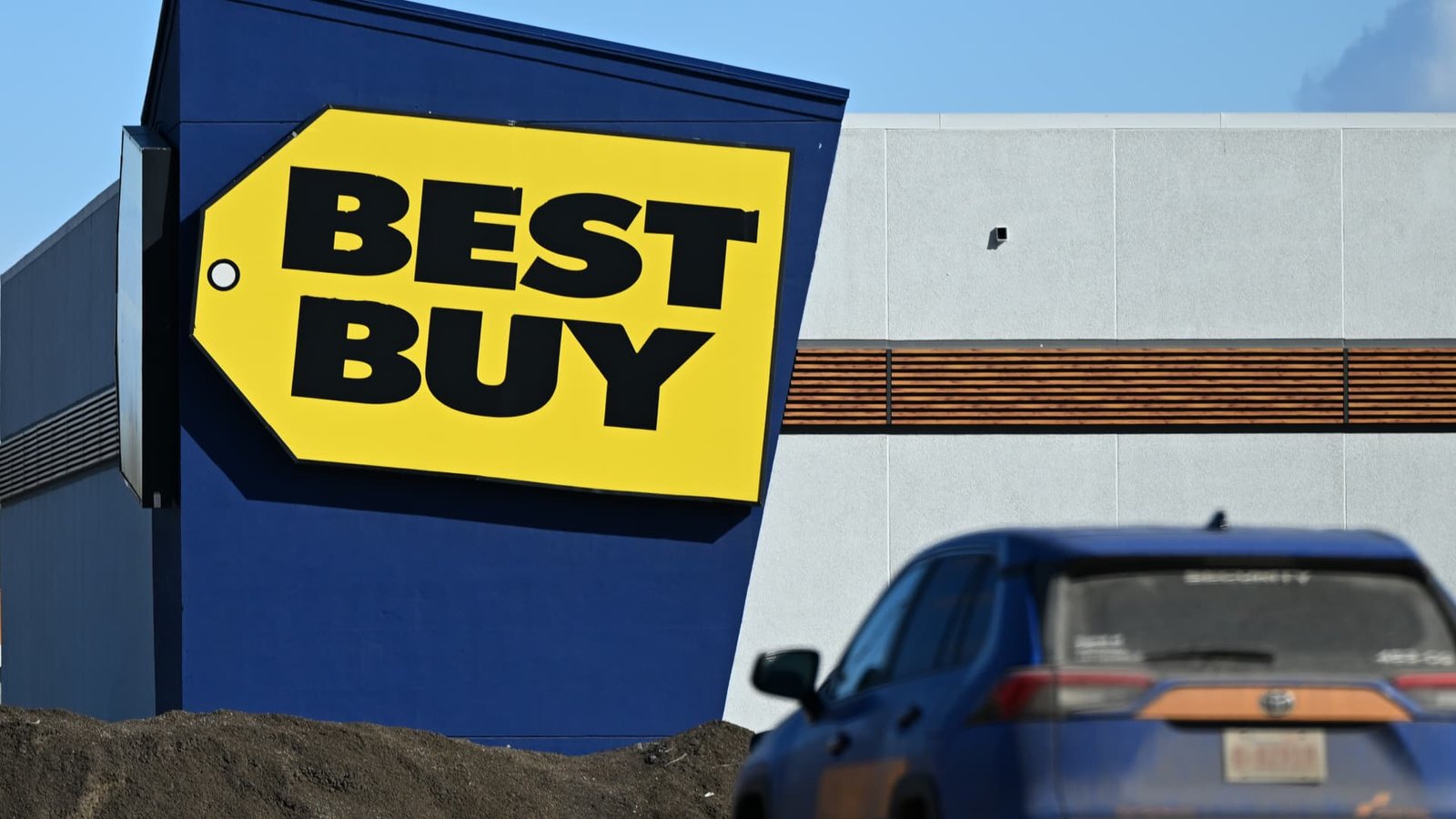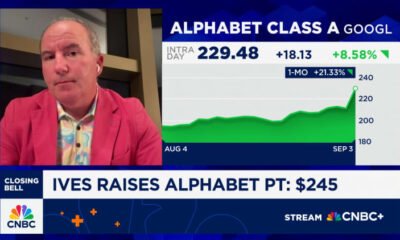Top Stories
Best Buy (BBY) earnings Q2 2026

Logo of Best Buy displayed outside a Best Buy store in Edmonton, Alberta, Canada, on March 22, 2025.
Artur Widak | Nurphoto | Getty Images
Best Buy surpassed Wall Street revenue and earnings expectations for its most recent quarter on Thursday, but stuck with its full-year forecast, citing tariff uncertainty.
The consumer electronics retailer said it expects revenue of $41.1 billion to $41.9 billion and adjusted earnings per share in a range of $6.15 to $6.30 for its full fiscal year 2026. In May, Best Buy had cut its full-year profit guidance from a prior range of $6.20 to $6.60.
For Best Buy, the middle of its expected full-year revenue range would be roughly flat to its revenue of $41.53 billion in the previous year. Best Buy said it expects full-year comparable sales, a metric that tracks online sales and sales at stores open at least 14 months, to range between a 1% decline and a 1% increase.
In a news release, CFO Matt Bilunas said the retailer is “increasingly confident about our plans for the back half of the year.” He said the company is “trending toward the higher end of our sales range.”
Yet he said, “given the uncertainty of potential tariff impacts in the back half, both on consumers overall as well as our business, we feel it is prudent to maintain the annual guidance we provided last quarter.”
Shares of Best Buy fell about 3% in premarket trading.
Here’s how the retailer did for the three-month period that ended August 2 compared with what Wall Street was expecting, according to a survey of analysts by LSEG:
- Earnings per share: $1.28 adjusted vs. $1.21 expected
- Revenue: $9.44 billion vs. $9.24 billion expected
For Best Buy, a challenging trifecta of factors have complicated the retailer’s outlook. Customers have bought fewer kitchen appliances as they put off home purchases and projects because of higher interest rates. Some have hesitated to splurge on pricier items because of tariff-related uncertainty or held out on tech replacements as they wait for new or eye-catching items. The company’s annual sales have declined for the past three years.
To spur growth, Best Buy launched a third-party marketplace earlier this month to offer shoppers a wider selection of consumer electronics, accessories and more. On the marketplace, sellers who apply for the platform can list their own brands and items on Best Buy’s website and app.
The company already increased prices on some items because of tariff-related higher costs, CEO Corie Barry said on a mid-May call with reporters. She did not specify which items now cost more and described price increases as “the very last resort.”
Best Buy’s net income for the fiscal second quarter of 2026 fell to $186 million, or 87 cents per share, from $291 million, or $1.34 per share, in the year-ago quarter. Adjusting for one-time items, including restructuring charges, Best Buy reported earnings per share of $1.28.
Revenue increased from $9.29 billion in the year-ago quarter.
Comparable sales rose 1.6% in the fiscal second quarter compared to the year-ago period. That marked the company’s highest growth in three years, CEO Corie Barry said in the company’s news release.
In the U.S., comparable sales increased 1.1%, as customers bought mobile phones, video gaming equipment and items from its computing category. However, those sales trends were partially offset by weaker sales of appliances, home theaters, tablets and drones, the company said.
Online sales in the U.S. rose 5.1% year over year and accounted for about a third of Best Buy’s total U.S. revenue in the quarter.
This is breaking news. Please check back for updates.
Top Stories
Trump calls on EU to impose 100% tariff on China and India to pressure Putin

US President Donald Trump has called on the European Union to hit China and India with tariffs of up to 100% as part of his efforts to force Russian President Vladimir Putin to end the war in Ukraine, a source familiar with the discussions has told the BBC.
He made the demand, first reported by the Financial Times, during a meeting between US and EU officials on Tuesday discussing options to increase economic pressure on Russia.
The proposal comes as Trump struggles to broker a peace deal between Moscow and Kyiv and as Russia’s strikes on Ukraine intensify.
Separately, Trump told reporters on Tuesday that he plans to talk to Putin on a call this week or early next week.
Ukraine’s main government building in Kyiv was struck by a Russian missile over the weekend – in an attack that was seen as both symbolic and a major increase of aggression by the Kremlin.
Over the weekend, attacks across the country marked the heaviest aerial bombardment on Ukraine since the war began. Ukraine said Russian forces used at least 810 drones and 13 missiles.
On Tuesday, more than 20 civilians were killed by a Russian glide bomb in the eastern Donbas region, as they queued to collect their pensions.
Speaking to reporters after the weekend bombardment, Trump said he was “not happy with the whole situation” and threatened harsher sanctions on the Kremlin.
The US president has previously threatened harsher measures against Russia, but not taken any action despite Putin ignoring his deadlines and threats of sanctions.
A highly anticipated summit between the leaders in Alaska last month ended without a peace deal.
Trump’s request to the European Union follows remarks from US Treasury Secretary Scott Bessent, who said Washington was prepared to escalate economic pressure but needed stronger European backing.
Trump also said on Tuesday that the US and India were “continuing negotiations to address the Trade Barriers” between the two countries.
He plans to speak to Indian Prime Minister Narendra Modi in the coming weeks and expects a “successful conclusion” to their trade talks, he wrote on his Truth Social platform.
In response to the post, Modi echoed Trump’s optimism that the talks would be successful and said the two countries were “close friends and natural partners.”
“Our teams are working to conclude these discussions at the earliest. I am also looking forward to speaking with President Trump,” he added.
Trump’s comments have been seen by some as the latest sign of a reconciliation between Washington and Delhi, after a collapse in their trade negotiations.
Last week, Trump emphasised the “special relationship” between India and the US, saying “there’s nothing to worry about. We just have moments on occasion”.
China and India are major buyers of Russian oil, which helps to keep the Russian economy afloat.
Last month, the US imposed a 50% tariff on goods from India, which included a 25% penalty for its transactions with Russia.
Although the EU has said it would end its dependency on Russian energy, around 19% of its natural gas imports still come from Russia.
If the EU does impose the tariffs on China and India it would mark a change to its approach of attempting to isolate Russia with sanctions rather than trade levies.
Top Stories
Horoscope for Wednesday, September 10, 2025 – Chicago Sun-Times

- Horoscope for Wednesday, September 10, 2025 Chicago Sun-Times
- Horoscopes Today, September 10, 2025 USA Today
- Your Daily Horoscope by Madame Clairevoyant: September 10, 2025 The Cut
- Horoscope for Wednesday, 9/10/25 by Christopher Renstrom SFGATE
- Your Daily Singles Horoscope for September 10, 2025 yahoo.com
Top Stories
Ford rolls out new ad campaign amid industry-wide uncertainty

Ford on Wednesday rolled out a new advertising campaign that the company said will mark a “fundamental shift” in its branding strategy — and comes as the auto industry deals with major uncertainty.
The automaker’s new strategy, titled “Ready, Set, Ford,” goes beyond vehicle-first advertising, Ford said, and instead focuses on the people who buy its cars. It involves four fundamental promises: capability, passion, community and trust.
The auto industry is facing a crucial crossroads as companies deal with President Donald Trump‘s tariffs and an overall consumer pullback in spending. Despite uncertainty with various sectoral tariffs, Trump’s auto tariffs have remained more or less unchanged, with a 25% tariff charge on imported cars and auto parts.
That timing, Ford Chief Marketing Officer Lisa Materazzo said, is intentional.
“The auto industry is in the midst of historic disruption. We are fortunate in the sense that Ford has an incredible 122-year history to leverage,” she said. “So because of that, we felt like there’s no better time to double down on our commitment to our brand and our consumers than now.”
Materazzo said the company engaged in extensive research ahead of the rollout, finding a common theme of uncertainty and anxiety from consumers due to a range of factors, including the political climate and the economy.
“The other thing we found is that consumers are surprisingly optimistic and resilient, especially when they feel empowered, and they’re seeking brands that help them navigate this uncertainty,” she said.
Ford has long championed its American roots and declared it’s the “most American automaker.” That identity is now crucial to the automaker’s brand, Materazzo said, and builds on its “America for America” campaign that offered employee pricing to all consumers shortly after tariffs were initially announced.
The new strategy aims to leverage Ford’s iconic brand while simultaneously signaling that the car company is entering a new era, Materazzo said. It will unify all of Ford’s global brands for the first time in decades under the new campaign, allowing the company to “represent ourselves very consistently around the globe,” she added.
“By Q1 of 2026, all of our global markets will be in market with ‘Ready, Set, Ford,'” Materazzo said. “The majority of them will do that by Q4 of this year.”
The first rollout of the ad is kicking off in conjunction with this week’s Thursday Night Football game, as the automaker aligns itself with the NFL season, one of the largest moneymakers for advertisements leading up to the Super Bowl.
During the Covid pandemic, the auto industry pulled back significantly on advertising and marketing budgets as it dealt with supply chain issues left companies without enough vehicles to sell. Many automakers returned to advertising during the NFL season last year as vehicle inventory levels returned to more normal levels.
Even as the macroenvironment signals uncertainty, Materazzo said the company is focused on continuing to deliver on its legacy and invest in its brand.
“The industry is in the middle of a transition right now. I don’t think all brands will survive, but I think those that not just survive, but thrive, will be the ones who recognize that one of their most valuable assets is their brand,” she said. “And if you don’t invest in your brand, you’re really disadvantaging your business for the long term.”
-

 Business2 weeks ago
Business2 weeks agoThe Guardian view on Trump and the Fed: independence is no substitute for accountability | Editorial
-
Tools & Platforms4 weeks ago
Building Trust in Military AI Starts with Opening the Black Box – War on the Rocks
-

 Ethics & Policy1 month ago
Ethics & Policy1 month agoSDAIA Supports Saudi Arabia’s Leadership in Shaping Global AI Ethics, Policy, and Research – وكالة الأنباء السعودية
-

 Events & Conferences4 months ago
Events & Conferences4 months agoJourney to 1000 models: Scaling Instagram’s recommendation system
-

 Jobs & Careers2 months ago
Jobs & Careers2 months agoMumbai-based Perplexity Alternative Has 60k+ Users Without Funding
-

 Education2 months ago
Education2 months agoVEX Robotics launches AI-powered classroom robotics system
-

 Podcasts & Talks2 months ago
Podcasts & Talks2 months agoHappy 4th of July! 🎆 Made with Veo 3 in Gemini
-

 Education2 months ago
Education2 months agoMacron says UK and France have duty to tackle illegal migration ‘with humanity, solidarity and firmness’ – UK politics live | Politics
-

 Funding & Business2 months ago
Funding & Business2 months agoKayak and Expedia race to build AI travel agents that turn social posts into itineraries
-

 Podcasts & Talks2 months ago
Podcasts & Talks2 months agoOpenAI 🤝 @teamganassi





















